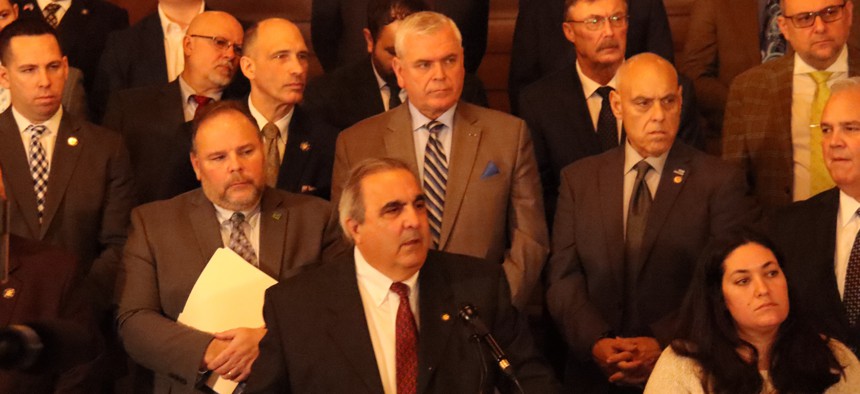Albany Agenda
Hochul’s proposal to close 5 more NY prisons rankles state GOP
The prison population has halved since 1999, and staffing is in freefall. But Republicans say the prisons should get more resources, not less.

Western New York Assembly Member Joseph Giglio speaks at a rally for keeping New York prisons open. Austin C. Jefferson
New York’s prison population has nearly halved since 1999, and there is a staffing shortage plaguing the state’s remaining facilities. But Gov. Kathy Hochul’s proposal to close five more state prisons in the next fiscal year has still irked state legislative Republicans – who said the plan disregards public safety and prison worker livelihoods.
On Wednesday, Republican state lawmakers held a press conference at the Capitol, arguing it is unfair to make the closures when prison violence is on the rise, correction officer recruitment is flagging and current officers would be given short notice.
In her budget proposal, Hochul included a plan to close up to five prisons in New York in the next fiscal year. The state has closed dozens of prisons in recent years, as the population of incarcerated people has shrunk to 32,500 from more than 70,000 in 1999, according to the governor’s office. The decrease is largely thanks to criminal justice reforms and repeals of the harsh Rockefeller drug laws. If the plan is approved, those prisons and their employees would be given a notice 90 days before their date of closure.
“This is just common sense,” said Assembly Member Phil Palmesano. “No more closures, especially with this insulting 90-day notification… The Legislature needs to act in addressing rising violence that continues to plague our correctional facilities.”
The Department of Corrections and Community Supervision said that while the closures would increase efficiency, no facilities have been identified yet.
"The Governor’s budget contains Article 7 language to allow the state to act expeditiously to right-size and eliminate excess capacity by allowing for the closure of up to five correctional facilities with 90 days’ notice, thus allowing for an increase in operational efficiency of the correctional system,” the state Department of Corrections and Community Supervision said in an email. “The facilities have not yet been identified."
Staffing has been looked at as a serious issue by state Department of Corrections and Community Supervision officials. Assembly Member Brian Maher said that closing the prisons was not a “long-term sustainable solution,” at least not for staffing issues.
“We are losing every two weeks, approximately 54 COs, and there are only 50 to 100 currently in training or at the academy,” Maher said he was told by Department of Corrections and Community Supervision officials. Maher’s winding district is home to the Eastern Correctional Facility in Napanoch
Staffing issues were a talking point at a public safety budget hearing last week. Acting DOCCS Commissioner Daniel Martuscello said that a driving force for the closures was a staffing crisis while noting that the incarcerated population had decreased significantly over the past two decades.
“We need to start getting realistic solutions before the National Guard becomes reality,” Maher later said. “I don't think anyone up here wants to see that happen.”
The dichotomy of the low staff and inmate headcounts serving as a cost-saving opportunity versus the livelihoods of employees working at these facilities is also a factor for lawmakers. But some have decried the reliance on prisons in local economies.
“We are well aware that many prison-adjacent communities across the state shamelessly depend on mass incarceration for jobs and related economic activity. Our bodies are not your cash crop,” said the Director of the Release Aging People in Prison Campaign Jose Saldana. “Still, we care about all people and, in that spirit, we must say: your lawmakers are failing you, if all they are doing is fecklessly complaining about prison closures.”
Prison violence, one of the reasons lawmakers said that the closures shouldn't come to pass, was called “unprecedented” in a report released last year. In line with the comments made by Republican lawmakers, violence against correctional facility staff rose by 25% from 2021 to 2022.
“The fact of the matter is everybody in a state facility is a felon,” said Assembly Member Joseph Giglio.

